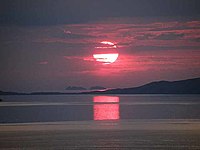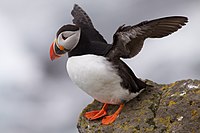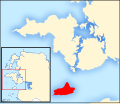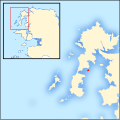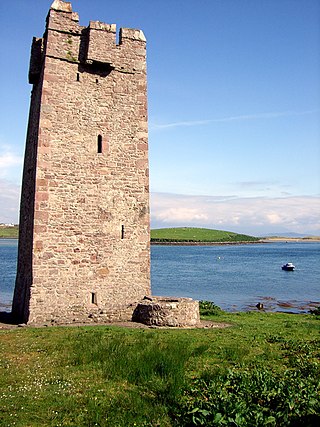


This articles lists the islands of County Mayo, the mainland of which is part of the island of Ireland. Included in this list are named offshore and freshwater islands as recorded by Ordnance Survey Ireland or the Placenames Database of Ireland. Additionally, areas of ecological significance related to both offshore and freshwater islands, designated by the National Parks and Wildlife Service, are also listed.
Contents
- Islands of Mayo by population
- Demographics
- Currently inhabited islands
- Formerly inhabited islands
- Islands of Mayo by area
- Larger islands
- Smaller offshore islands
- Freshwater islands
- Lough Mask
- Lough Carra
- Lough Corrib
- Lough Conn
- Smaller lakes
- Monastic islands
- Biodiversity
- Special areas of conservation
- Special protection areas
- Natural heritage areas
- Proposed natural heritage areas
- Island index
- Notes
- References
- See also
Although County Mayo has hundreds of offshore and freshwater islands, only a handful of islands and island groups are large enough to be distinguishable on a typical map of the county, namely Achill Island, Clare Island and Inishturk, along with the island clusters of Duvillaun, Inishkea, Clew Bay and the major loughs. There are over 100 islands which are greater than 10 acres (4.0 ha) in area. The largest island is Achill, which extends to 148 km2 (37,000 acres), making it Ireland's largest offshore island. [2]
Due to its abundance of bays, inlets and offshore islands, Mayo is reputed to have the longest coastline of any county in Ireland, at 1,168 km (726 mi) or approximately 21% of the total coastline of the State. [3] [4]
The geology and geomorphology of the county and its islands is among the most varied and complex in Ireland. Islands such as those at Clew Bay are low-lying, formed when rising sea levels drowned a vast field of drumlins, while others like Clare Island and Achill are characterised by mountains and towering sea-cliffs, of which Croaghaun are the third-highest in Europe, at 688 m (2,257 ft) [5]
The bedrock geology of the islands is broadly divided into two groups. Those north of Clew Bay such as Achill and the islands off the Mullet Peninsula are generally of ancient Dalradian age, similar to County Donegal and the Grampian Highlands. Inishglora contains some of the oldest rocks in Ireland, at 1.75 billion years old. Further south, the islands are much more diverse. Clare island alone is composed of Cambrian, Ordovician, Silurian and Carboniferous terranes sutured together. Geologically, the Clew Bay islands themselves are the youngest in the county, formed during the Lower Carboniferous about 350 million years ago. [6]
The county's offshore islands - and islands off the west coast of Ireland generally - developed their own distinct culture and traditions stretching back centuries. Records from the 1841 Census show that 47 of County Mayo's offshore islands were inhabited, with a combined population of approximately 10,000. [n 1] [7] The Great Famine resulted in widespread or total depopulation of the islands. Towards the end of the 19th century the population of the larger islands began to recover somewhat, only to be set back by emigration following independence as the Irish government initially encouraged the evacuation of the islands due to the cost of providing services to them, further hastening the decline. [8]
Today, the islands are recognised by the State as an integral part of Ireland's national heritage, preserving the remnants of a unique aspect of Irish culture. The remaining inhabited islands receive support and funding through the Department of Culture, Heritage and the Gaeltacht. [9] As of the 2016 Census, there are 2,700 people living on 14 of the county's offshore islands (of which 2,440 live on Achill), accounting for 1.87% of the county's population. [10]























